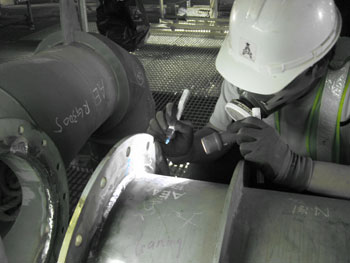 Visual Inspection is one of the most common and most powerful means of non-destructive testing. Visual testing requires adequate illumination of the test surface and proper eye-sight of the tester. To be most effective visual inspection does however, merit special attention because it requires training (knowledge of product and process, anticipated service conditions, acceptance criteria, record keeping, for example) and it has its own range of equipment and instrumentation. It is also a fact that all defects found by other NDT methods ultimately must be substantiated by visual inspection. VT can be classified as Direct visual testing, Remote visual testing and Translucent visual testing. The most common NDT methods MT and PT are indeed simply scientific ways of enhancing the indication to make it more visible. Often the equipment needed is simple for internal inspection, light lens systems such as bore scopes allow remote surfaces to be examined. More sophisticated devices of this nature using fibre optics permit the introduction of the device into very small access holes and channels. Most of these systems provide for the attachment of a camera to permit permanent recording.
Visual Inspection is one of the most common and most powerful means of non-destructive testing. Visual testing requires adequate illumination of the test surface and proper eye-sight of the tester. To be most effective visual inspection does however, merit special attention because it requires training (knowledge of product and process, anticipated service conditions, acceptance criteria, record keeping, for example) and it has its own range of equipment and instrumentation. It is also a fact that all defects found by other NDT methods ultimately must be substantiated by visual inspection. VT can be classified as Direct visual testing, Remote visual testing and Translucent visual testing. The most common NDT methods MT and PT are indeed simply scientific ways of enhancing the indication to make it more visible. Often the equipment needed is simple for internal inspection, light lens systems such as bore scopes allow remote surfaces to be examined. More sophisticated devices of this nature using fibre optics permit the introduction of the device into very small access holes and channels. Most of these systems provide for the attachment of a camera to permit permanent recording.
HITECH NDT Services material testing facility contains light meters, welding gauges, magnifiers, lenses, other measuring instruments and equipments for precise control of surface HITECH. Our NDT inspectors, engineers and technicians are qualified to NDT Level I, II as per written practice prepared according to ASNT recommended practice SNT-TC-1A and in-house ASNT NDT Level IIIs for providing inspection and consulting services.


